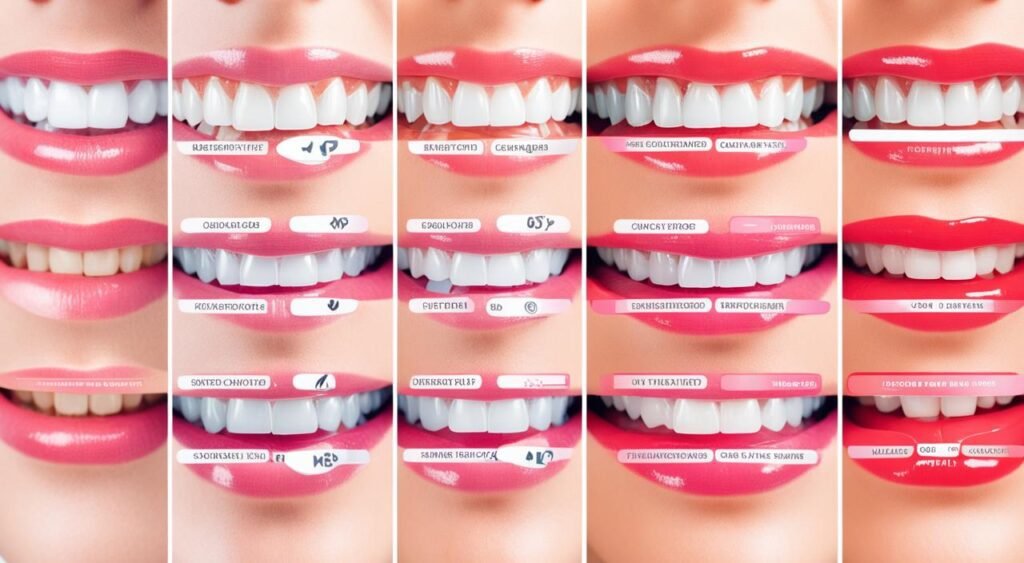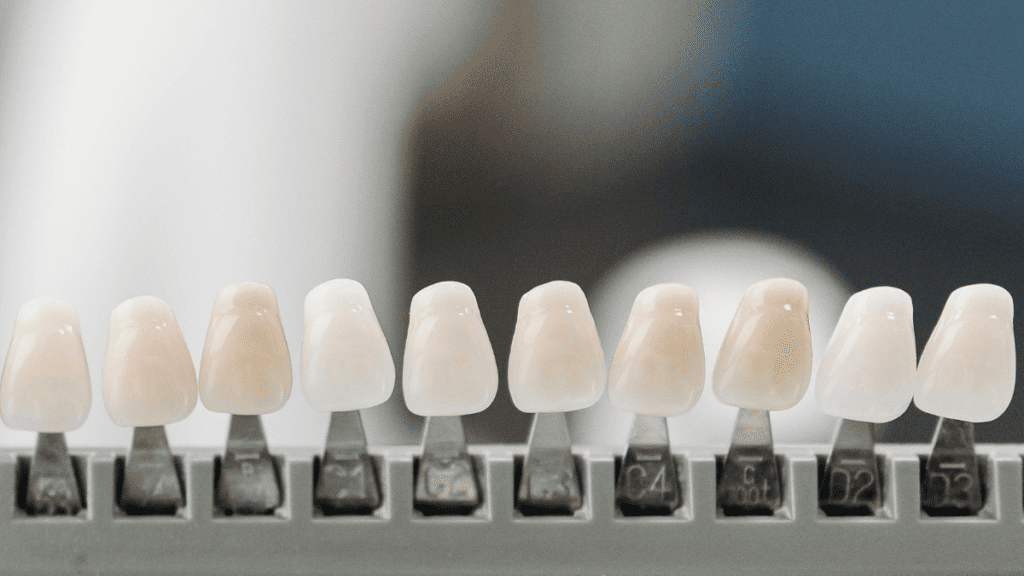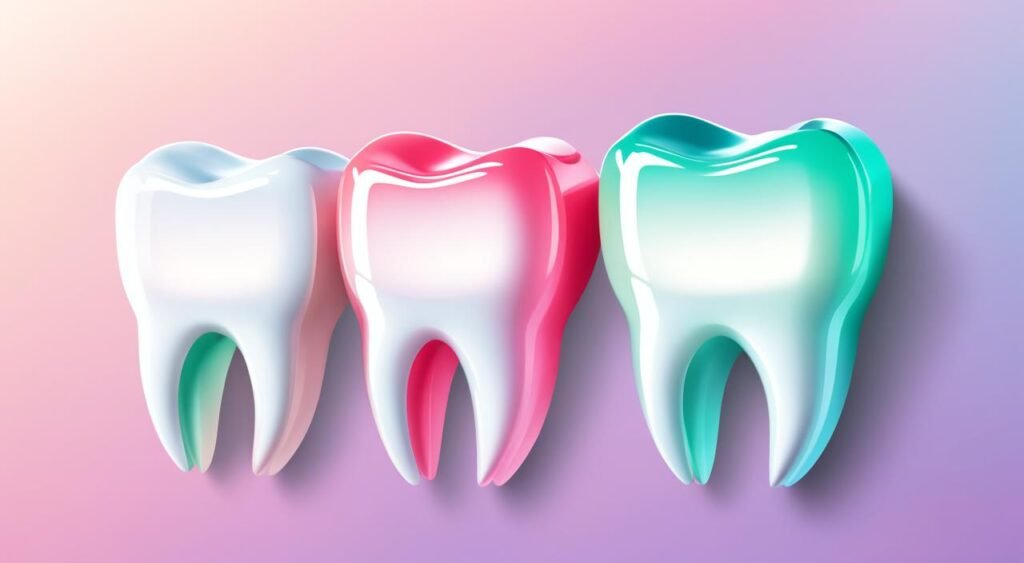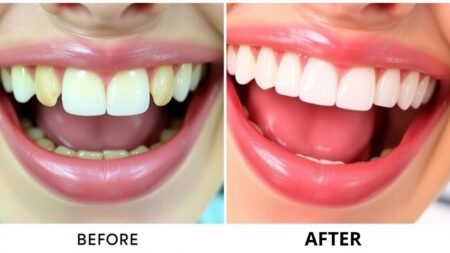Embarking on the journey to enhance your smile with dental veneers involves more than just a commitment to cosmetic improvement; it requires an understanding of the veneers cost involved. In the realm of cosmetic dentistry expenses, veneers stand out as a popular choice for those looking to achieve a dazzling smile transformation.
As with any significant investment, you’ll find that dental veneers pricing can vary widely, influenced by a myriad of factors such as materials, dentist expertise, and geographic location. Before you decide to proceed with this impactful procedure, it’s critical to get a clear picture of the potential costs to fully appreciate the value of this investment in your self-confidence and dental health.
Remember, the price tag on veneers goes beyond the immediate aesthetic perks; it encompasses the quality of materials, the precision of custom fitting, and the lasting benefits of a durable, beautiful smile. As you consider the range of cosmetic dentistry expenses, keep in mind that the initial cost reflects the longevity and satisfaction that quality veneers can offer. Now, let’s delve into what you need to know about dental veneers pricing to determine whether it’s the right choice for your smile goals and budget.
Understanding Dental Veneers and Their Purpose
A smile makeover is more than just an enhancement of your look; it’s an investment in your overall confidence and quality of life. Dental veneers stand at the forefront of cosmetic dental solutions, offering a path to a transformed smile. In this section, we’ll delve into the world of dental veneers, explore their benefits, and compare them to other dental procedures.
What Are Dental Veneers?
Dental veneers are custom-made shells designed to cover the front surface of teeth, improving their appearance. They are typically made from porcelain or resin composite materials and are permanently bonded to your teeth. Veneers can alter the size, shape, color, or length of your teeth, leading to an impeccable, natural-looking smile.
The Role of Veneers in Cosmetic Dentistry
The role of dental veneers in cosmetic dentistry cannot be overstated. Veneers offer numerous dental veneers benefits, such as correcting stains, chips, misalignment, and gaps between teeth. Not only do they enhance aesthetic appeal but they also provide a protective layer, contributing to the overall health of your teeth.
Comparing Veneers to Other Dental Procedures
Considering a smile makeover, you might wonder how veneers stack up against other procedures. Let’s compare the attributes of veneers with other popular treatments:
| Procedure | Results | Durability | Cost |
|---|---|---|---|
| Veneers | Immediate improvement in appearance | 10-15 years | Higher upfront, fewer touch-ups needed |
| Teeth Whitening | Whiter smile, but may not correct shape | Several months to a few years | Lower, but requires regular maintenance |
| Braces | Alignment correction over time | Permanent, if retainers are used | Varies, often includes additional costs |
| Crowns | Restoration of tooth’s form and function | 5-15 years | Comparable to veneers, depends on material |
In essence, dental veneers offer a high-value, long-term solution within the field of cosmetic dental solutions. Though the initial investment may be greater than some alternatives, the lasting effects and minimal need for further procedures make veneers an attractive choice for a lasting smile makeover.
Factors Influencing the Cost of Veneers
When considering a dental cosmetic investment, understanding cost determinants is crucial to effectively budgeting for your new smile. There are several veneers pricing factors that can lead to a wide range of costs for this procedure. Here, we’ll discuss some of these pivotal elements that dictate the final pricing of dental veneers.

- The number of veneers you need will be one of the most apparent cost determinants. A full set will naturally cost more than a partial set meant to address only the most visible teeth.
- Another variable is the complexity of your case. More complex dental issues might require additional preparatory work or specialized techniques, which can influence the overall dental cosmetic investment.
- Your location also plays a part; there are marked geographic variations in veneers pricing factors. Typically, metropolitan areas with a higher cost of living might see pricier dental services compared to smaller towns.
- Furthermore, the expertise and reputation of the dentist is pivotal. Renowned dental professionals or those with advanced certifications in cosmetic dentistry are likely to charge more for their services.
- Lastly, the type of material chosen for the veneers significantly affects the price; high-quality materials like porcelain might be more of an investment but offer superior durability and aesthetics.
| Cost Factor | How It Affects Pricing |
|---|---|
| Number of Veneers | Affects the total material and labor costs |
| Case Complexity | More complex cases require additional procedures and time |
| Geographic Location | Varies with regional economic conditions and cost of living |
| Dentist’s Expertise | Highly regarded professionals often have higher rates |
| Type of Material | Material quality can affect longevity and aesthetics of veneers |
While exploring your options for veneers, consider these aspects as an essential guide to shaping your dental cosmetic investment. Each of these factors can impact your veneers pricing factors, and therefore, the final decision should be made in consultation with a trustworthy dental professional to ensure your needs are met within your budget.
Types of Veneers and Their Price Ranges
When considering a smile makeover, it’s crucial to understand the options available to you and their respective costs. Veneers offer a transformative solution, but their pricing can vary widely depending on the type you choose. Let’s explore the common types of veneers and what you can expect in terms of investment.
Porcelain Veneers: A Premium Option
Known for their durability and natural look, porcelain veneers come with a higher price tag, reflecting their quality. When discussing porcelain veneers pricing with your dentist, consider that they often last 10 to 15 years, if not longer, with proper care. While the initial cost may be more substantial, the long-term aesthetics and resilience can justify the investment.
Composite Resin Veneers: A Cost-Effective Alternative
If the porcelain option strains your budget, you might find composite veneers affordability appealing. These veneers are sculpted on your teeth directly, usually requiring less tooth enamel removal. This also means the process is reversible—a factor to consider if you’re looking for flexibility. Although composite veneers tend to have a shorter lifespan, their ease of repair and lower upfront cost make them a viable option.
Lumineers: Understanding the Cost vs. Benefits
Lumineers cost is something of a middle ground in veneer pricing. As a no-preparation alternative—meaning little to no tooth enamel is removed—Lumineers are thinner and less invasive. This type of veneer can be an excellent choice if you’re seeking a less permanent change. However, they might not mask tooth discoloration as effectively as thicker porcelain veneers. Weighing the cost against the non-invasive benefits will guide your decision.
Remember, while the cost is an important consideration, so is the quality of your dental investment. It’s always recommended to consult with a trusted dental professional who can guide you through the options based on your specific needs.
Average Veneers Cost in the United States
When you’re considering the enhancement of your smile with veneers, it’s important to understand the financial aspect of this cosmetic investment. The average veneers cost USA can give you a ballpark figure, but remember, various factors can influence the final amount.

State-by-State Cost Variations
One of the significant factors is the dental cost by state, as prices for cosmetic procedures vary significantly across the country. While some states may offer more affordable options, others can have a higher price tag due to economic conditions or demand.
| State | Average Cost Range |
|---|---|
| California | $900 – $2,500 per tooth |
| New York | $1,000 – $3,000 per tooth |
| Texas | $700 – $2,000 per tooth |
| Florida | $800 – $2,500 per tooth |
| Illinois | $900 – $2,700 per tooth |
How Insurance and Financing Options Affect Pricing
Next on your checklist is to gauge the extent of veneers insurance coverage you have, if any. Most dental insurances classify veneers as a cosmetic procedure and don’t cover them; however, certain financing options can make the process more manageable financially.
It’s advisable to speak with your dentist about payment plans or third-party financing that can soften the immediate economic impact of your veneer treatment.
Long-Term Investment: Cost Over Time
Veneers should not only be viewed as a cost but as a long-term investment in your oral health and self-confidence. It’s important to consider the longevity of veneers and potential savings from not needing other cosmetic dental work as frequently. By maintaining good oral hygiene and regular dental check-ups, you ensure that your investment stands the test of time.
Preparation and Procedure: Additional Cost Considerations
When you consider enhancing your smile with dental veneers, understanding the full financial implications is essential, especially when it comes to preparation expenses and additional dental fees that extend beyond the baseline dental veneers procedure costs. The price tag for a veneer treatment is not exclusive to the veneers themselves; it encompasses a variety of services that ensure the durability and success of your cosmetic enhancement.
The initial consultation is where your journey begins, and this appointment may bring its own charges. During this visit, your dentist evaluates your dental health, discusses potential treatments, and may take x-rays. Think of these preparatory steps as the foundation of your veneer procedure because they determine the best course of action for your unique needs. However, these necessary diagnostics add to your bill, constituting a segment of the overall preparation expenses.
Moreover, there might be additional preparatory work needed before affixing the veneers. Tooth shaping, for instance, is a common requirement that tailors the tooth surface to securely anchor the veneer—this, too, comes at an added expense. It’s paramount to factor in these expenses while budgeting for your smile transformation.
Remember to consider possible additional dental fees that may arise during or after the procedure. Follow-up visits, adjustments, and unforeseen complications, although not common, can incrementally increase your overall expenditure.
| Preparation Step | Average Cost | Purpose |
|---|---|---|
| Initial Consultation | $100 – $200 | Assessment of dental health and treatment planning. |
| X-Rays | $20 – $250 | Underlying dental structure imaging to guide precise veneer fit. |
| Tooth Shaping | $50 – $300 per tooth | Contouring of the teeth to accommodate veneer placement. |
| Follow-Up Visits | $50 – $150 per visit | Ensuring proper fit and comfort of veneers after placement. |
While these numbers provide an average range, your exact dental veneers procedure costs and related fees will likely be tailored to your specific situation and geographic location. Always request a comprehensive treatment plan from your dentist that includes all anticipated costs, so you can make an informed decision about this worthwhile investment in your smile.
Maintaining Your Veneers: Longevity and Aftercare Expenses
Investing in dental veneers is just the beginning. To truly get the most out of your new smile, understanding the veneers maintenance costs and aftercare expenses is essential. Good maintenance not only helps in extending veneer lifespan but also ensures that your smile remains as stunning as the day you got them. Let’s delve into the recommended care routines and the potential costs associated with veneer upkeep.
Regular dental check-ups are paramount in maintaining the integrity of your veneers. During these visits, a dental professional can spot any issues early, which can save you from incurring hefty costs down the line. The following table outlines the typical aftercare expenses you might expect:
| Aftercare Service | Estimated Cost | Frequency |
|---|---|---|
| Professional Cleaning | $75 – $200 | Every 6 months |
| Examination & Consultation | $50 – $150 | Each visit |
| Minor Adjustments | $100 – $200 | As required |
The key to reducing veneers maintenance costs lies in your daily habits. Be mindful of chewing hard foods and using your teeth as tools, which can damage your veneers. Additionally, impeccable oral hygiene — brushing twice daily, flossing, and using a non-abrasive fluoride toothpaste — is non-negotiable.
- Brush gently with a soft-bristled toothbrush.
- Avoid staining substances like coffee, red wine, and tobacco.
- Wear a guard if you grind your teeth at night.
Consider these steps not as mere suggestions, but as integral parts of your lifestyle to prevent unnecessary aftercare expenses. By taking proactive measures, you’re not just caring for your veneers; you’re safeguarding the investment in your smile.
Remember, the longevity of your veneers doesn’t solely depend on the quality of the material or the expertise of your dentist. It’s the consistent aftercare that makes all the difference.
The Bottom Line: Is the Veneers Cost Worth Your Smile Transformation?
When it comes to evaluating veneers cost, it’s essential to consider the broader picture beyond the initial price tag. A smile makeover is not just a cosmetic enhancement; it’s an investment in yourself that bears a value difficult to quantify. The confidence that comes with a transformed smile can open doors in both your personal and professional life, contributing towards a positive self-image and wellbeing. As you weigh the pros and cons, think about how the durability and quality of dental veneers stand in relation to their cost – and how this aligns with your long-term goals for aesthetic and oral health.
Gauging the true worth of dental veneers investment means looking at tangible and intangible returns. While the monetary aspect is clear, calculating smile makeover value stretches into the realm of psychological benefits. Testimonials from individuals who’ve taken the step reveal a common theme: an enhanced quality of life and a boost in self-esteem. These personal accounts, coupled with studies that affirm the social advantages of an attractive smile, paint a holistic picture of the potential impact on your life.
In summary, your decision about whether or not to proceed with veneers should balance your budget with your desire for improved aesthetics and the attendant benefits. Each case is unique, and your valuation of these factors will be personal. Reflect on the lasting benefits that a radiant, confident smile could offer you and consider if this facet of cosmetic dentistry resonates with your pursuit of happiness and success. The choice is yours, but remember, a great smile is an asset that continues to give, long after the procedure is completed.
FAQ
How much do veneers typically cost?
The cost of veneers can vary widely based on various factors, with prices ranging from $500 to $2,500 per tooth. It’s important to consider the full scope of expenses, not just the initial price.
What are dental veneers?
Dental veneers are thin, custom-made shells designed to cover the front surface of teeth to improve their appearance. They are bonded to the teeth and can change their color, shape, size, or length.
What role do veneers play in cosmetic dentistry?
Veneers are a popular cosmetic dentistry solution for achieving a smile makeover. They can effectively address a variety of aesthetic concerns, such as discoloration, chips, gaps, or misshapen teeth.
How do dental veneers compare to other procedures like braces or teeth whitening?
Veneers offer more immediate visual changes in comparison to braces and can address a wider range of aesthetic issues than teeth whitening. While veneers are more costly upfront, they can provide a more dramatic and durable smile transformation.
What factors influence the cost of dental veneers?
The cost of veneers is affected by the material used (porcelain or composite), the number of veneers needed, the complexity of the patient’s case, the dentist’s expertise, and the geographic location of the dental practice.
What are the price ranges for different types of veneers?
Porcelain veneers tend to be the most expensive, often costing $1,000 to $2,500 per tooth, while composite resin veneers may range from $500 to $1,500 per tooth. Lumineers, a type of ultra-thin porcelain veneers, can also fall within this price range but may vary based on individual cases.
What’s the average veneers cost across the United States?
The average cost of veneers in the U.S. varies, but typically falls between $1,000 and $2,000 per tooth. Costs can be significantly higher or lower depending on the state and local market rates.
Can insurance or financing options help with the cost of veneers?
Most dental insurance plans do not cover veneers as they are considered a cosmetic procedure. However, many dental offices offer financing options to make the cost more manageable.
What long-term costs should be considered when getting veneers?
Beyond the initial investment, you should consider maintenance and aftercare expenses such as regular dental check-ups, potential repairs, or replacing veneers over time, which can add to the cost.
What additional expenses are involved in the veneer procedure?
In addition to the veneers themselves, you may incur costs for the initial consultation, preparatory work like x-rays or tooth shaping, and any necessary follow-up visits.
How can I extend the lifespan of my veneers and what are the maintenance costs?
With proper care, veneers can last 10-15 years or longer. Regular dental check-ups, proper oral hygiene, and avoiding habits that could damage the veneers are important. Maintenance costs will include these check-ups and occasional professional cleanings.
Is the veneers cost worth it for a smile transformation?
Many find the cost of veneers to be a worthwhile investment for the confidence and satisfaction that comes with a transformed smile. It’s a personal decision, and considering both the aesthetic and psychological benefits can help you decide if it’s the right choice for you.









1 Comment
Pingback: Veneers Before and After: Stunning Smile Transformations in 2024